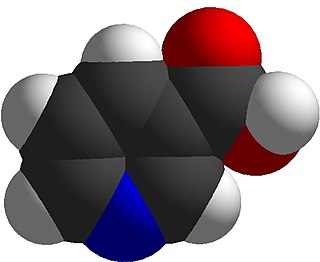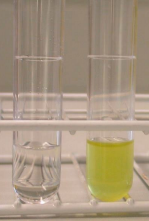High-density lipoprotein (HDL) is one of the five major groups of lipoproteins. Lipoproteins are complex particles composed of multiple proteins which transport all fat molecules (lipids) around the body within the water outside cells. They are typically composed of 80–100 proteins per particle and transporting up to hundreds of fat molecules per particle.

Niacinamide or Nicotinamide (NAM) is a form of vitamin B3 found in food and used as a dietary supplement and medication. As a supplement, it is used by mouth to prevent and treat pellagra (niacin deficiency). While nicotinic acid (niacin) may be used for this purpose, niacinamide has the benefit of not causing skin flushing. As a cream, it is used to treat acne. It is a water-soluble vitamin. Niacinamide is the supplement name while Nicotinamide (NAM) is the scientific name.

A vitamin is an organic molecule (or a set of molecules closely related chemically, i.e. vitamers) that is an essential micronutrient that an organism needs in small quantities for the proper functioning of its metabolism. Essential nutrients cannot be synthesized in the organism, either at all or not in sufficient quantities, and therefore must be obtained through the diet. Vitamin C can be synthesized by some species but not by others; it is not a vitamin in the first instance but is in the second. The term vitamin does not include the three other groups of essential nutrients: minerals, essential fatty acids, and essential amino acids. Most vitamins are not single molecules, but groups of related molecules called vitamers. For example, there are eight vitamers of vitamin E: four tocopherols and four tocotrienols. Some sources list fourteen vitamins, by including choline, but major health organizations list thirteen: vitamin A (as all-trans-retinol, all-trans-retinyl-esters, as well as all-trans-beta-carotene and other provitamin A carotenoids), vitamin B1 (thiamine), vitamin B2 (riboflavin), vitamin B3 (niacin), vitamin B5 (pantothenic acid), vitamin B6 (pyridoxine), vitamin B7 (biotin), vitamin B9 (folic acid or folate), vitamin B12 (cobalamins), vitamin C (ascorbic acid), vitamin D (calciferols), vitamin E (tocopherols and tocotrienols), and vitamin K (phylloquinone and menaquinones).

Niacin, also known as nicotinic acid, is an organic compound and a form of vitamin B3, an essential human nutrient. It can be manufactured by plants and animals from the amino acid tryptophan. Niacin is obtained in the diet from a variety of whole and processed foods, with highest contents in fortified packaged foods, meat, poultry, red fish such as tuna and salmon, lesser amounts in nuts, legumes and seeds. Niacin as a dietary supplement is used to treat pellagra, a disease caused by niacin deficiency. Signs and symptoms of pellagra include skin and mouth lesions, anemia, headaches, and tiredness. Many countries mandate its addition to wheat flour or other food grains, thereby reducing the risk of pellagra.

William Sheehan is an American musician. He is best known for playing the bass guitar with acts such as Talas, Steve Vai, David Lee Roth, Mr. Big, Niacin, and The Winery Dogs. He is also known for his "lead bass" playing style, including the use of chording, two-handed tapping, "three-finger picking" technique and controlled feedback. Sheehan has been voted "Best Rock Bass Player" five times in Guitar Player readers' polls.

Pellagra is a disease caused by a lack of the vitamin niacin (vitamin B3). Symptoms include inflamed skin, diarrhea, dementia, and sores in the mouth. Areas of the skin exposed to either sunlight or friction are typically affected first. Over time affected skin may become darker, stiffen, peel, or bleed.
ATC code C10Lipid modifying agents is a therapeutic subgroup of the Anatomical Therapeutic Chemical Classification System, a system of alphanumeric codes developed by the World Health Organization (WHO) for the classification of drugs and other medical products. Subgroup C10 is part of the anatomical group C Cardiovascular system.
Megavitamin therapy is the use of large doses of vitamins, often many times greater than the recommended dietary allowance (RDA) in the attempt to prevent or treat diseases. Megavitamin therapy is typically used in alternative medicine by practitioners who call their approach orthomolecular medicine. Vitamins are useful in preventing and treating illnesses specifically associated with dietary vitamin shortfalls, but the conclusions of medical research are that the broad claims of disease treatment by advocates of megavitamin therapy are unsubstantiated by the available evidence. It is generally accepted that doses of any vitamin greatly in excess of nutritional requirements will result either in toxicity or in the excess simply being metabolised; thus evidence in favour of vitamin supplementation supports only doses in the normal range. Critics have described some aspects of orthomolecular medicine as food faddism or even quackery. Research on nutrient supplementation in general suggests that some nutritional supplements might be beneficial, and that others might be harmful; several specific nutritional therapies are associated with an increased likelihood of the condition they are meant to prevent.

Fenofibrate, is an oral medication of the fibrate class used to treat abnormal blood lipid levels. It is less commonly used compared than statins because it treats a different type of cholesterol abnormality to statins. While statins have strong evidence for reducing heart disease and death, there is evidence to suggest that fenofibrate also reduces to the risk of heart disease and death. However, this seems only to apply to specific populations of people with elevated triglyceride levels and reduced high-density lipoprotein (HDL) cholesterol. Its use is recommended together with dietary changes.

Clofibric acid is a biologically active metabolite of the lipid-lowering drugs clofibrate, etofibrate and theofibrate with the molecular formula C10H11ClO3. It has been found in the environment following use of these drugs, for example in Swiss lakes and the North Sea.

Picamilon is a drug formed by a synthetic combination of niacin and γ-aminobutyric acid (GABA). It was developed in the Soviet Union in 1969 and further studied in both Russia and Japan as a prodrug of GABA.

Clofibride is a fibrate. Clofibride is a derivative of clofibrate. In the body it is converted into 4-chlorophenoxyisobutyric acid, which is the true hypolipidemic agent. So clofibride, just like clofibrate is a prodrug of clofibric acid.
Aluminium clofibrate is a fibrate.

Hydroxycarboxylic acid receptor 2 (HCA2), also known as niacin receptor 1 (NIACR1) and GPR109A, is a protein which in humans is encoded by the HCAR2 gene. HCA2, like the other hydroxycarboxylic acid receptors HCA1 and HCA3, is a Gi/o-coupled G protein-coupled receptor (GPCR). The primary endogenous agonists of HCA2 are D-β-hydroxybutyric acid and butyric acid (and their conjugate bases, β-hydroxybutyrate and butyrate). HCA2 is also a high-affinity biomolecular target for niacin (aka nicotinic acid).

Niacin/lovastatin was a drug combination used for the treatment of dyslipidemia. It was a combination of the lipid-modifying drug/vitamin niacin in extended release form and the statin drug lovastatin. The combination preparation was developed by Kos Pharmaceuticals, Inc., which was acquired by Abbott Laboratories in 2006, subsequently transferred to AbbVie Inc. when that company was spun off from Abbott in January 2013.

Niacin/simvastatin is a combination drug consisting of an extended release form of the lipid-lowering drug niacin and the statin drug simvastatin. It is used for the treatment of dyslipidemia. It was approved by the FDA on February 15, 2008. On April 15, 2016, the FDA pulled the approval of niacin and fibrates used in combination with statin drugs, citing growing evidence that the benefits of combining niacin or fibrate drugs with statin drugs to not outweigh the risks, compared to statin therapy alone. This ruling applied to Advicor in addition to Simcor.

Laropiprant (INN) was a drug used in combination with niacin to reduce blood cholesterol that is no longer sold, due to increases in side-effects with no cardiovascular benefit. Laropiprant itself has no cholesterol lowering effect, but it reduces facial flushes induced by niacin.

The niacin test has been widely used since the 1960s to identify mycobacteria at the species level in the clinical laboratory. The niacin test detects niacin in aqueous extracts of a culture. M. tuberculosis strains that test negative for the niacin test are very rare. Redox reactions happening in Mycobacterium species produce niacin as a part of energy metabolism. Even though all mycobacteria produce niacin, M. tuberculosis accumulates an excess of niacin because of its inability to process niacin, excreting the excess niacin into the culture media, thus allowing it to be detected using the niacin test. The niacin test is typically only conducted on slow-growing, granular, tan colored colonies, as these are the morphology characteristics of M. tuberculosis on an agar plate. Because of its affordability compared to expensive identification methods like pyrosequencing or MALDI-TOF MS that require expensive machines and reagents.

Vitamin B3, colloquially referred to as niacin, is a vitamin family that includes three forms or vitamers: niacin (nicotinic acid), nicotinamide (niacinamide), and nicotinamide riboside. All three forms of vitamin B3 are converted within the body to nicotinamide adenine dinucleotide (NAD). NAD is required for human life and people are unable to make it within their bodies without either vitamin B3 or tryptophan. Nicotinamide riboside was identified as a form of vitamin B3 in 2004.
The Coronary Drug Project (CDP) was a large clinical trial which assessed several different treatments for coronary heart disease in men with previous myocardial infarction. The study was conducted from 1965 to 1985 at 53 clinical centers and randomized 8,341 men age 30 to 64 years to six different treatment groups: low-dose estrogen therapy, high-dose estrogen therapy, clofibrate (1.8 g/day), dextrothyroxine (6 mg/day), niacin (3 g/day), and placebo.















